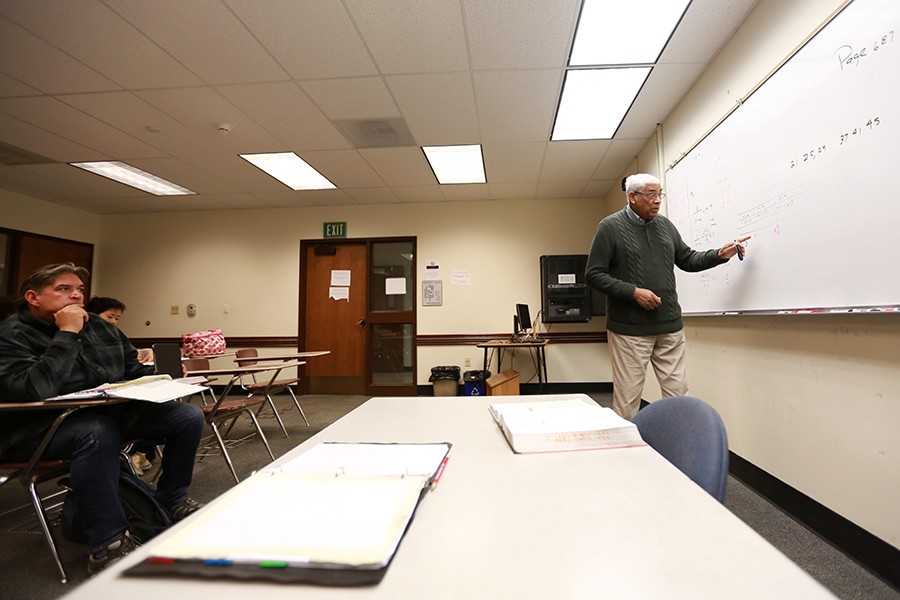Classes combine, increase success
Math 118 and Math 120 are planned to be combined in order to heighten student success. Only 35 percent of students who enroll in Math 120 and 15 percent from Math 118 eventually enroll in Math 164, Introduction to Probability and Statistics.
Nov 18, 2015
The possibility of two math courses being combined and units counted as transferable is a plan for spring 2016.
Mathematics professor Susan Van Hattum said mathematics department Chairperson Terrill Mead met with individuals associated with the student success equity board earlier this semester trying to authorize a combination of both math courses.
Contra Costa College students will have a higher chance of passing math courses. They will be able to move on to other math courses sooner if the combination of both happens, she said.
“Right now we have a compressed schedule where students have to take Math 118 (Elementary Algebra) or lower during a semester based on their assessment scores. Then, Math 120 (Intermediate Algebra) whenever they can in order to enroll in a higher level of math courses for graduation or to transfer,” Van Hattum said.
“Those of us who teach math on this campus love it and wish students would love math too. However, that is not always the case because there currently is no other alternative except for our Math 125 (Algebra for Statistics) course.”
She said Math 125 has a higher success rate and students enrolled in any math class can enroll in Math 164 (Introduction to Probability and Statistics) after passing Math 125, and skipping Math 120.
“A lot of students don’t know about the class because it is known as 100-A in the class schedule,” Van Hattum said. “That is old news because they have changed the name since and we have three courses being offered for the spring.”
She said the combination of Math 118 and Math 120 does not guarantee combined transferable units. Math 125 can be the easy way out for students who dislike math.
“It’s the biggest news right now in our math department because the students who do not generally care for math want to get through stats and go on to a four-year institution,” Van Hattum said. “We don’t want math here on campus to get in the way students surviving college, or fail college, but that’s what happens. MATH-125 can change all that.”
Mathematics professor Emanuel Baptiste said, “If they allow for the (cohort) and it pushes through (the combination of the two classes Math 118, Math 120), then it will get students ready for statistics.”
Art major Amanda Trujillo said she found English courses easier than math courses at the college.
“I wish that it would have came into fruition sooner because math is hard. Especially after you take a couple of years off from school after high school like I did,” she said. “If they do it then students should take advantage of it.”
She said she stopped with math after passing statistics in four semesters, and is currently in her fifth semester.
Undecided major Amarjit Singh said math came natural him and he started in Math 120 after the assessment tests.
He spends time studying calculus with a group of students inside the Hub in the Physical Sciences Building.
Singh said the combination of courses should happen if it makes transferring easy for students not good in math.
“If I did not do so well in the math assessment test then I would not know where I would be,” he said.
According to the California Acceleration Project, a statewide program in support of redesigning community colleges developmental English and math curriculum and increasing student completion, students are determined to have a 70 percent chance of being unprepared for college math.
Van Hattum said that is not right because the college assessment tests score the tests lower than they should.
She said for every student who begins one level below the transfer level of statistics in Math 120, 35 percent of them will complete statistics within three years.
If they begin two levels below transfer in Math 118, she said the number drops to 15 percent.
Three levels in classes lower than Math 115, it is only 6 percent. It is just “horrible,” she said.
“Overall, there are five scenarios for students where something can go wrong,” Van Hattum said. “And that is not even factoring in your personal life.”
She said the economics and ethnicity of individuals interlink the endeavors of students struggling to get through the required math classes, and those who are not good with numbers associated with algebra and statistics.


